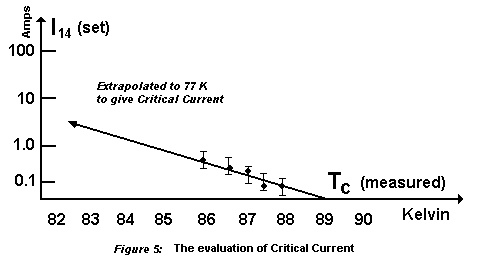The four point probe device can be used to measure the Critical Current Density (Jc) of the superconductor materials in our kits. Theoretically, one could measure Jc of the probe immersed in liquid nitrogen, by boosting the applied current I14 until a transition to non-superconducting state occurs. Practically, this procedure would damage the probe permanently. The following procedure will help preserve the integrity of your superconducting four point probe device. This procedure also has the added advantage of obtaining Critical Current values at different operating temperatures.
For this experiment, a power supply capable of up to 0.5 Amp output is required. Connect the device to the digital voltmeters and power supply as shown in figure 2 earlier in this Experiment Guide. A constant current source that can be set to output a range of current values up to 0.5 Amp will make the execution of this experiment considerably easier. Proceed with the following directions:
- ACTION
Set the current through probes 1 and 4 at 0.1 Amp, and measure the Critical Temperature as described in the Resistance vs. Temperature experiment. Record the measured Tc versus the value of current used. - ACTION
Now increase the set current to 0.2 Amp, and repeat the process in action item 1, above. Keep repeating the process with 0.1 Amp increments in current, taking care not to exceed a maximum of 0.5 Amp.
RESULT
Five data points will be obtained, each at a Critical Temperature, Tc, versus a set current, I14. An appropriate extrapolation (curve fit) to 77 Kelvin will result in the Critical Current for the superconductor. The Critical Current Density (Jc) can then be estimated from the probe geometry listed in the table below. Figure 5, below shows an example of the result with a Bi2Sr2Ca2Cu3O10 based four point probe.
This is a difficult experiment. The data is electrically 'noisy'. Some improvement in the signal-to-noise ratio may be achieved by making several independent measurements at each current setting.
| Material | Diameter | Thickness | Probe 1&4 spacing |
Probe 2&3 spacing |
Probe depth |
|---|---|---|---|---|---|
YBa2Cu3O7 |
24 mm |
4 mm |
17.5 mm |
11 mm |
1.5 mm |
Bi2Sr2Ca2Cu3O10 |
30 mm |
5 mm |
17.5 mm |
11 mm |
1.5 mm |

Information Courtesy of CSI Superconductors

